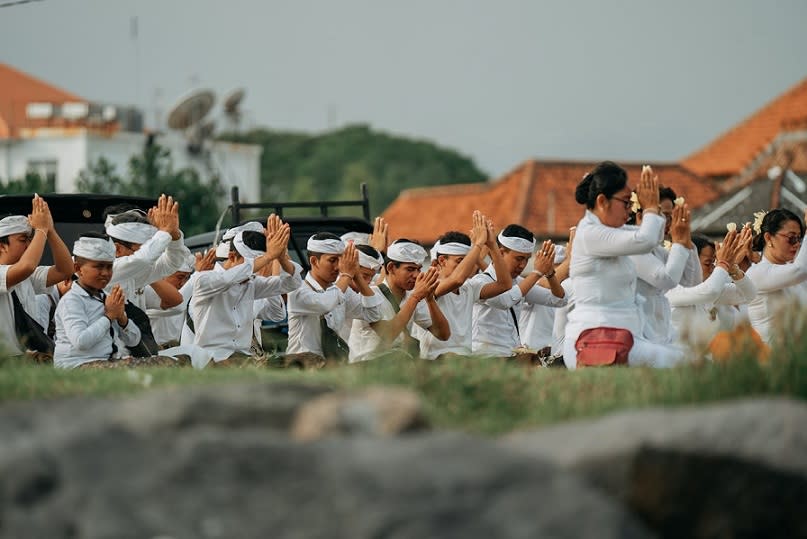Enter the colourful Balinese Galungan, Kuningan, and Nyepi celebrations

There are numerous manifestations of religious celebrations, marking individual, and communal occasions, such as rites of passage, communal cleansing ceremonies, thanksgiving, and new year festivities.
The most ubiquitous celebrations are the ones marking the festivities and celebrations of different faiths, such as Hari Raya Aidilfitri, Christmas, Chinese New Year, and Deepavali.
Some of these celebrations are loud, with cacophonic explosions of sounds, music, chanting, and firecrackers, while a few are meditative and reflective.
One such religious celebration is the Balinese Hindu Galungan, Kuningan, and Nyepi, which celebrates the Balinese New Year. Unlike other New Year celebrations, the Balinese New Year is a peaceful and sedate affair.
It is sublime yet minimalistic in its offerings of flowers and penjor (decorated bamboo poles).
While other religious celebrations are physical and extrovert, with extravagant displays of ritualistic paraphernalia, the Balinese celebrations focus on the internal self, and the energy linking it with the environment and cosmic energy through meditation and reflection, to achieve pramna.
Galungan is a Balinese religious holiday that celebrates the triumph of dharma (right) over adharma (wrong). This celebration that marks the visit of the ancestral spirits’ return to Earth is called Galungan, while their return on the last day, is called Kuningan.
The visit and presence of the ancestral spirits are symbolised by the decorated penjor, which are bamboo poles with offerings suspended at the end, placed on roadsides, in front of houses.
The Balinese year based on the Pawukon calendar has 210 days. Thus, they could celebrate Galungan and Kuningan twice in a Roman calendar year.
Galungan begins on Wednesday (Buda) on the eleventh week of the Pawukon calendar. It was celebrated on Feb 28 this year. Kuningan ends on March 9, after which comes the day of the Nyepi (day of silence) on March 12.
During Galungan and Kuningan, the Balinese spend their days in prayer, especially the first few days of the celebration. They visit the main puras (temples) to pray, making offerings of flowers, fruits, and food to their Hindu, and local deities. They do this individually or in a family group, and also in procession.
Unlike the processions of other faiths that are usually accompanied with a loud din and sounds, the Balinese procession is sedate, with the men and women wearing white shirts and kebaya respectively, walking silently in procession, carrying offerings of flowers and fruits, accompanied with the peal of a gong and/or a flute. The procession of men, women, and children accompanies the Barong to the purwa for communal purification and blessings.
The Barong, consisting of a lion, dragon, or other animal mask with protruding eyes and a long body, is a sacred effigy and the protector of the village. It has magical powers to neutralise evil forces and restores balance in individuals and communities.
During the Galungan festivities, Barong dances are ubiquitous, roaming the streets and going from house to house, bringing blessings and healings.
Nyepi is a Balinese Hindu day of silence to commemorate the Isakawarsa (new year) based on the Balinese Pawukon calendar of 210 days.
It is mainly celebrated in Bali and is marked by a day of silence, fasting, and meditation. The day after Nyepi is celebrated as New Year’s Day.
The Nyepi, celebrated on March 12 this year, is a day of self-reflection marked by several restrictions – no lighting of fires, lights must be kept low, no working, entertainment, or pleasure, no travelling, and for some, fasting.
The Balinese are confined to their home, leaving the streets deserted. It is a day of rest for both human and the environment, and for humans to reflect on his or her existence, vis-à-vis the environment, the physical, and spiritual cosmos.
Tourists are not bound by these restrictions but they are confined to the hotels and are not allowed on the streets or beaches. Only security patrols are on the streets to ensure the observance of these Nyepi restrictions. And the Ngurarai airport is closed for the day.
There are several rituals that are performed before the day of the Nyepi, among which is the Melasti Ritual, performed in a pura near the sea, three to four days before Nyepi, dedicated to Sanghyang Widhi Wasa to purify sacred objects belonging to several temples, and to source sacred water from the sea.
The spectacular ogoh-ogoh ritual, in which demonic statues made from cloth and styrofoam and richly painted are paraded around the village or in the city in a rite called pengrupukan, is held on the last day before Nyepi. The purpose of this rite is the cleansing and purification of the environment of negative elements. After the parade, these figurines are burnt in the cemetery as a symbol of purification for the new year.
The Balinese religious festivals of Galungan, Kuningan and Nyepi are unique in its meditative and reflective elements and their connection with the environment through its floral and penjor offerings.
These festivals are not only religious but also aesthetic and artistic in nature, as seen in the various forms of floral, fruits, and decorative offerings.
The post Enter the colourful Balinese Galungan, Kuningan, and Nyepi celebrations appeared first on Twentytwo13.


